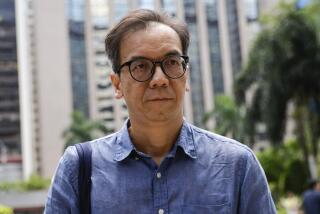Cultural Exchange: Hong Kong comics industry back in the game
- Share via
Hong Kong — Times were good in the 1970s and ‘80s for Hong Kong comics — so good that one publisher was listed on the stock exchange and a newspaper dedicated to the genre published daily for two years. They were, in the words of Tony Wong, the creator of the Oriental Heroes action series whom fans, artists and scholars have dubbed the territory’s godfather of comics, “the golden years.”
In recent years, comics publishers here in one of the world’s largest markets for the genre have slimmed down. Wong, chairman of the Hong Kong Comics and Animation Federation and director of Jade Dynasty publisher, said revenues started falling in the early 2000s and have not stopped since. Vincent Yeung, an adviser to the federation when it was developing a smartphone app to promote and distribute local comics, said that since 1995, the total revenue from comics in the territory had dropped 40%.
But change is afoot, and nowhere is it more evident than in one section of Wan Chai, one of the city’s oldest and busiest districts. In recent months, the government’s urban renewal authority and the Hong Kong Arts Centre have been sprucing up a cluster of crumblingpre-war buildings into a hub for cartoonists and animators called Comix Home Base. It is slated to open next year, when the city hosts the International Comic Artist Conference.
The comics publishers that flourished in the heyday of the genre are getting to work on the Web. Comics publishing and licensing company Culturecom has made some titles available free online to attract readers. Jade Dynasty put its comics up for paid viewing online last year. This year, it will start offering titles viaChina’sTencent service provider.
Meanwhile, a new crop of talent has emerged. Hong Kong Arts Centre Executive Director Connie Lam said that in the past decade, independent artists who broke from the action genre had gained a foothold, attracting attention at home and abroad. “A lot of people cannot see the whole picture of comics here. A more diverse range of artists and expression can be found now.”
Unlike the earlier artists who focus on fighting and vengeance and aim for a visual realism, the new ones have tended toward depictions of daily life in the city with a hint of nostalgia or local humor, often using cartoon-like characters. In doing so, they have managed to tug at the heartstrings of a populace that wants to forge its own identity following the British colony’s return to Chinese rule in 1997. Readers have flocked to them, and, recognizing their influence, so have marketers. Stella So’s intricate drawings of Hong Kong buildings and people, for example, have been picked up by the likes of 7-Eleven and local fast-food chain Maxim’s, while a panda character by Cheung Chi-hin, known by his pen name Siuhak, has landed on such items as evaporated milk, moon cakes and Mid-Autumn Festival treats.
“A decade after the hand-over, an awareness of preservation has started to emerge,” Cheung said. “The younger generation are starting to feel a sense of belonging to the city and believe that Hong Kongers should have a culture that belongs to themselves.”
Cheung credits newspapers and magazines, which in recent years have started putting independent comics in their pages, and Joint Publishing, which started a book category dedicated to local comics in 2006. So far, the company has published 40 titles by 12 independent artists.
Meanwhile, the Museum of Art is showing the work of early cartoon artist Feng Zikai and the Heritage Museum is carrying an exhibition on Louie Yu Tin, who created cartoon character Wong Lung-woo, popular in the 1940s and ‘50s. Under an initiative to support creative industries, the government is also injecting $1.8 million into projects to help local comics, including for exhibitions and the development of an app, called Hong Kong Comics.
“The comics sector is widely recognized as one of the common sources of creative inspiration for many other sectors of our entertainment industries, ranging from film, TV, video games to amusement parks,” said Jerry Liu, head of CreateHK, the government’s arm for promoting creative enterprises.
Yeung said the Internet and digital platforms were helping promote newcomers and making it possible for them to gain entry minus the cost of publishing a book. Maggie Lau, who got her start uploading still and flash images of characters on MaggieMarket.com, and Kong Khong-chang, an artist known for his Ricegas and Penguin Lab series are prime examples.
The city’s comics industry blossomed after World War II and came of age in the ‘70s and ‘80s, when Wong and another artist, Ma Wing-shing, separately emerged with their own distinctive styles and respectively created Oriental Heroes and Chinese Hero, two of the city’s most popular comics.
The woes in Hong Kong are similar to those in Japan and the United States, the world’s top comics markets. With the proliferation of online games, new media and networking, the visual narrative format must fight much harder for readers’ attentions.
Wendy Wong, author of “Hong Kong Comics: A History of Manhua” and an associate professor of communication design at Swinburne University of Technology in Australia, said that in terms of impact and influence, nothing had yet emerged to rival the work of Wong and Ma’s time. But there is a sense that the industry is regaining steam. Tony Wong, for one, is eager to see what Internet sales will bring. “This is a time of change,” he said. “Before, it was new media that attacked old media, but now, old media is using new media.”
More to Read
The biggest entertainment stories
Get our big stories about Hollywood, film, television, music, arts, culture and more right in your inbox as soon as they publish.
You may occasionally receive promotional content from the Los Angeles Times.










